Comprehensive Assessment and Nursing Care Plan Report: NUR251 S219
VerifiedAdded on 2022/09/18
|14
|3311
|27
Report
AI Summary
This report provides a comprehensive medical-surgical nursing assessment and care plan for a patient, David, focusing on acute kidney injury (AKI). Task 1 details the assessment process, including physical and vital signs, pain (using the PQRST algorithm), and fluid balance. Task 2 presents a nursing care plan addressing acute pain, risk of fluid imbalance, risk of infection, anxiety, and impaired skin integrity, outlining goals, interventions, and rationales. Task 3 highlights key recommendations for David, emphasizing fluid balance and pain management, and the importance of patient education. Task 4 describes the clinical reasoning cycle used in providing care, from initial assessment to intervention and evaluation. The report emphasizes the importance of monitoring vital signs, pain levels, and fluid balance to improve patient outcomes and well-being. The assessment includes a review of David's condition, including vital signs, lab results, and urine output, as well as the application of the clinical reasoning cycle to guide nursing interventions and patient care.
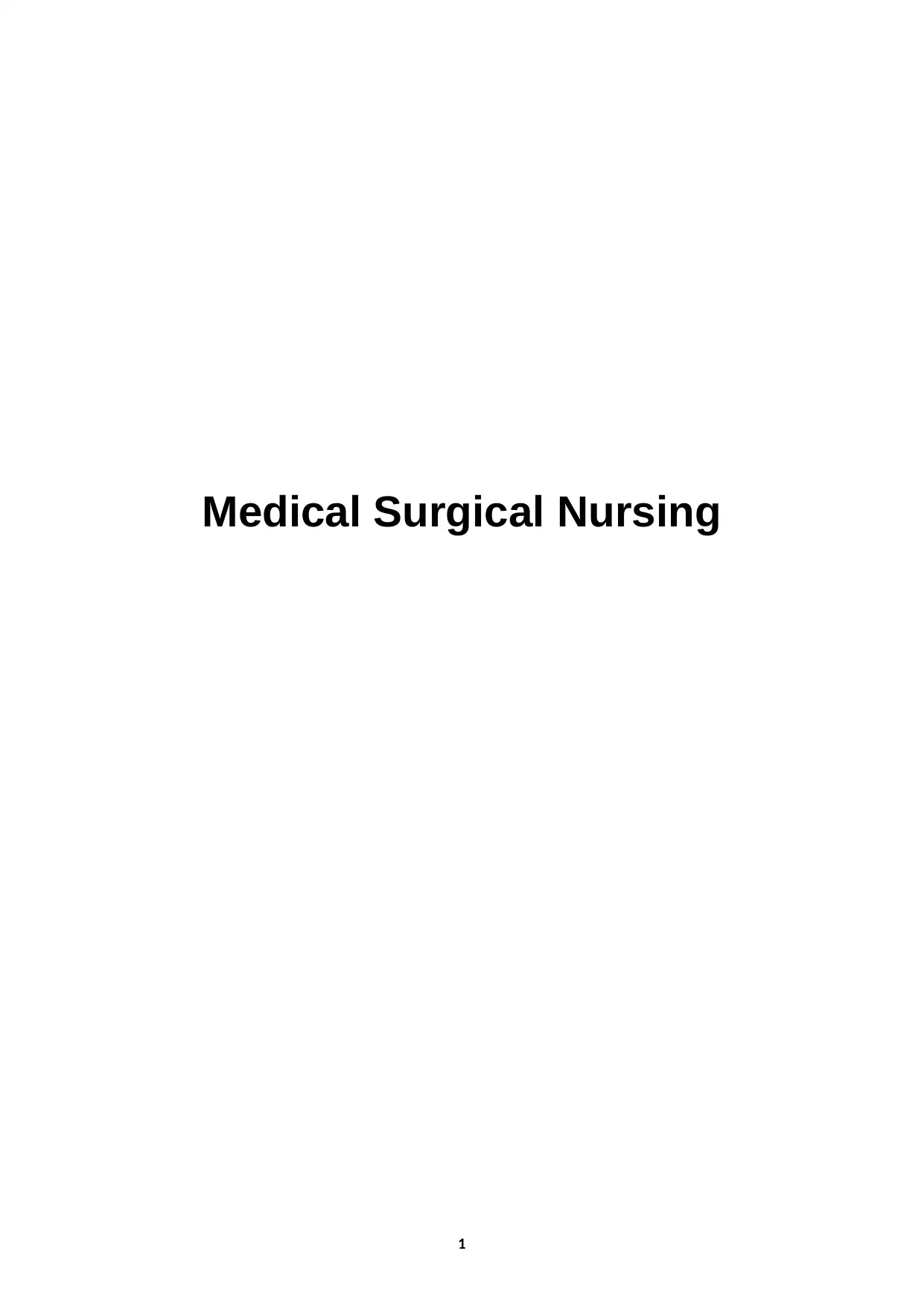
Medical Surgical Nursing
1
1
Paraphrase This Document
Need a fresh take? Get an instant paraphrase of this document with our AI Paraphraser
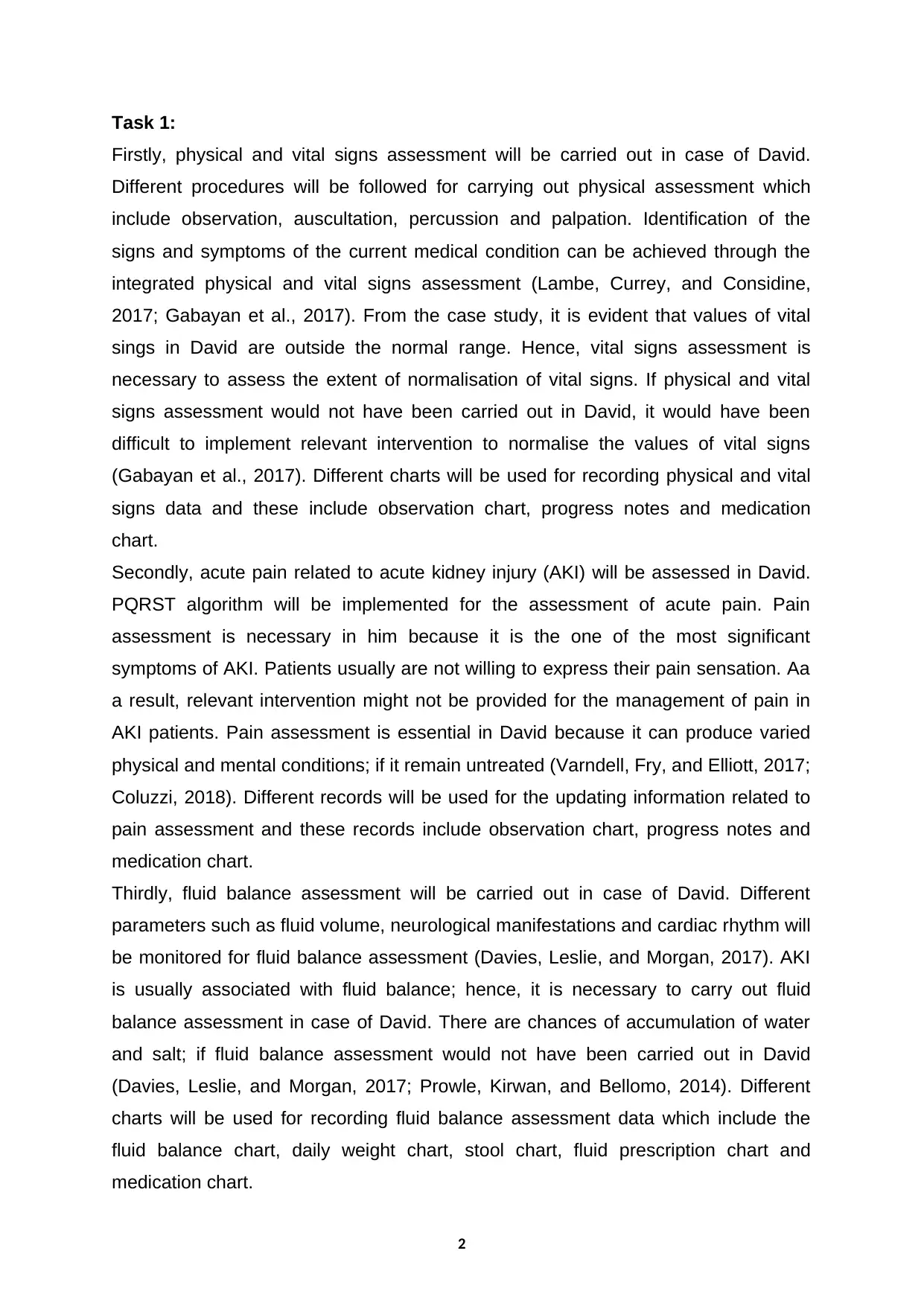
Task 1:
Firstly, physical and vital signs assessment will be carried out in case of David.
Different procedures will be followed for carrying out physical assessment which
include observation, auscultation, percussion and palpation. Identification of the
signs and symptoms of the current medical condition can be achieved through the
integrated physical and vital signs assessment (Lambe, Currey, and Considine,
2017; Gabayan et al., 2017). From the case study, it is evident that values of vital
sings in David are outside the normal range. Hence, vital signs assessment is
necessary to assess the extent of normalisation of vital signs. If physical and vital
signs assessment would not have been carried out in David, it would have been
difficult to implement relevant intervention to normalise the values of vital signs
(Gabayan et al., 2017). Different charts will be used for recording physical and vital
signs data and these include observation chart, progress notes and medication
chart.
Secondly, acute pain related to acute kidney injury (AKI) will be assessed in David.
PQRST algorithm will be implemented for the assessment of acute pain. Pain
assessment is necessary in him because it is the one of the most significant
symptoms of AKI. Patients usually are not willing to express their pain sensation. Aa
a result, relevant intervention might not be provided for the management of pain in
AKI patients. Pain assessment is essential in David because it can produce varied
physical and mental conditions; if it remain untreated (Varndell, Fry, and Elliott, 2017;
Coluzzi, 2018). Different records will be used for the updating information related to
pain assessment and these records include observation chart, progress notes and
medication chart.
Thirdly, fluid balance assessment will be carried out in case of David. Different
parameters such as fluid volume, neurological manifestations and cardiac rhythm will
be monitored for fluid balance assessment (Davies, Leslie, and Morgan, 2017). AKI
is usually associated with fluid balance; hence, it is necessary to carry out fluid
balance assessment in case of David. There are chances of accumulation of water
and salt; if fluid balance assessment would not have been carried out in David
(Davies, Leslie, and Morgan, 2017; Prowle, Kirwan, and Bellomo, 2014). Different
charts will be used for recording fluid balance assessment data which include the
fluid balance chart, daily weight chart, stool chart, fluid prescription chart and
medication chart.
2
Firstly, physical and vital signs assessment will be carried out in case of David.
Different procedures will be followed for carrying out physical assessment which
include observation, auscultation, percussion and palpation. Identification of the
signs and symptoms of the current medical condition can be achieved through the
integrated physical and vital signs assessment (Lambe, Currey, and Considine,
2017; Gabayan et al., 2017). From the case study, it is evident that values of vital
sings in David are outside the normal range. Hence, vital signs assessment is
necessary to assess the extent of normalisation of vital signs. If physical and vital
signs assessment would not have been carried out in David, it would have been
difficult to implement relevant intervention to normalise the values of vital signs
(Gabayan et al., 2017). Different charts will be used for recording physical and vital
signs data and these include observation chart, progress notes and medication
chart.
Secondly, acute pain related to acute kidney injury (AKI) will be assessed in David.
PQRST algorithm will be implemented for the assessment of acute pain. Pain
assessment is necessary in him because it is the one of the most significant
symptoms of AKI. Patients usually are not willing to express their pain sensation. Aa
a result, relevant intervention might not be provided for the management of pain in
AKI patients. Pain assessment is essential in David because it can produce varied
physical and mental conditions; if it remain untreated (Varndell, Fry, and Elliott, 2017;
Coluzzi, 2018). Different records will be used for the updating information related to
pain assessment and these records include observation chart, progress notes and
medication chart.
Thirdly, fluid balance assessment will be carried out in case of David. Different
parameters such as fluid volume, neurological manifestations and cardiac rhythm will
be monitored for fluid balance assessment (Davies, Leslie, and Morgan, 2017). AKI
is usually associated with fluid balance; hence, it is necessary to carry out fluid
balance assessment in case of David. There are chances of accumulation of water
and salt; if fluid balance assessment would not have been carried out in David
(Davies, Leslie, and Morgan, 2017; Prowle, Kirwan, and Bellomo, 2014). Different
charts will be used for recording fluid balance assessment data which include the
fluid balance chart, daily weight chart, stool chart, fluid prescription chart and
medication chart.
2

3
⊘ This is a preview!⊘
Do you want full access?
Subscribe today to unlock all pages.

Trusted by 1+ million students worldwide

Task 2
Nursing Care Plan: David Smith
Nursing problem: Acute Pain
Related to: Acute kidney injury
Goal of care Nursing interventions Rationale Evaluation
Reduce pain
sensation and
minimise pain rating
on pain scale.
Apply PQRST algorithm to record pain
rating.
Observe, monitor and interpret non-
verbal communication.
Encourage David to report pain
instantaneously. Acknowledge the pain
reports.
Information about pain rating on the
pain scale is beneficial in planning
relevant intervention (Pham et al.,
2017).
Most of the patients do not verbalise
pain; hence, non-verbal
communications can provide clue
about the pain. Hence,
subsequently relevant
communication can be provided to
the patient (Pham et al., 2017).
Persistent pain can produce
psychological problems such as
depression and anxiety; hence it is
necessary to report it immediately.
Moreover, instantaneous pain
reporting by patient and immediate
response form the nurse can build
positive therapeutic relationship
between the nurse and the patient
(Duke, Botti, and Hunter, 2012).
Observed pain score is 2/10 on pain
scale.
4
Nursing Care Plan: David Smith
Nursing problem: Acute Pain
Related to: Acute kidney injury
Goal of care Nursing interventions Rationale Evaluation
Reduce pain
sensation and
minimise pain rating
on pain scale.
Apply PQRST algorithm to record pain
rating.
Observe, monitor and interpret non-
verbal communication.
Encourage David to report pain
instantaneously. Acknowledge the pain
reports.
Information about pain rating on the
pain scale is beneficial in planning
relevant intervention (Pham et al.,
2017).
Most of the patients do not verbalise
pain; hence, non-verbal
communications can provide clue
about the pain. Hence,
subsequently relevant
communication can be provided to
the patient (Pham et al., 2017).
Persistent pain can produce
psychological problems such as
depression and anxiety; hence it is
necessary to report it immediately.
Moreover, instantaneous pain
reporting by patient and immediate
response form the nurse can build
positive therapeutic relationship
between the nurse and the patient
(Duke, Botti, and Hunter, 2012).
Observed pain score is 2/10 on pain
scale.
4
Paraphrase This Document
Need a fresh take? Get an instant paraphrase of this document with our AI Paraphraser
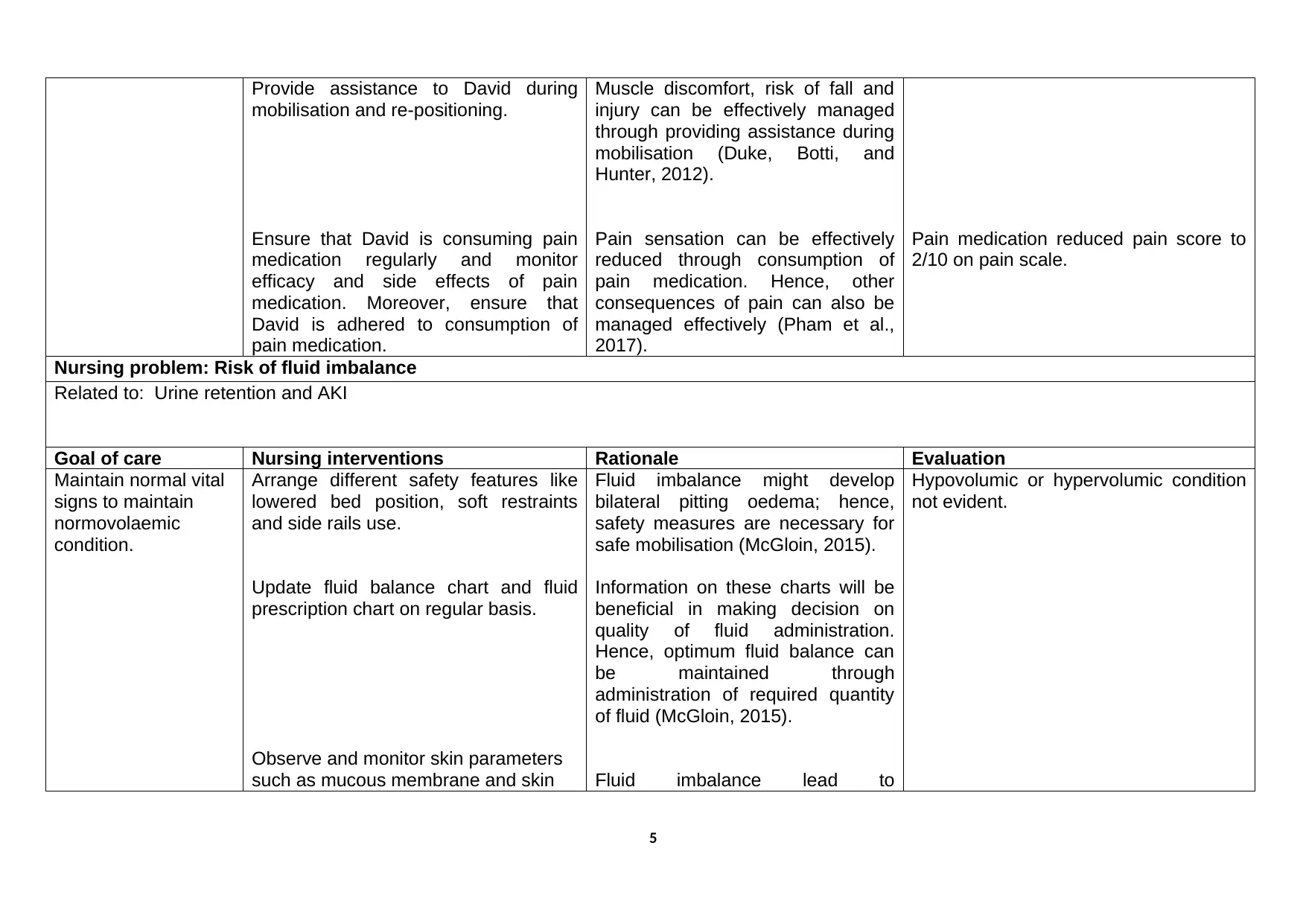
Provide assistance to David during
mobilisation and re-positioning.
Ensure that David is consuming pain
medication regularly and monitor
efficacy and side effects of pain
medication. Moreover, ensure that
David is adhered to consumption of
pain medication.
Muscle discomfort, risk of fall and
injury can be effectively managed
through providing assistance during
mobilisation (Duke, Botti, and
Hunter, 2012).
Pain sensation can be effectively
reduced through consumption of
pain medication. Hence, other
consequences of pain can also be
managed effectively (Pham et al.,
2017).
Pain medication reduced pain score to
2/10 on pain scale.
Nursing problem: Risk of fluid imbalance
Related to: Urine retention and AKI
Goal of care Nursing interventions Rationale Evaluation
Maintain normal vital
signs to maintain
normovolaemic
condition.
Arrange different safety features like
lowered bed position, soft restraints
and side rails use.
Update fluid balance chart and fluid
prescription chart on regular basis.
Observe and monitor skin parameters
such as mucous membrane and skin
Fluid imbalance might develop
bilateral pitting oedema; hence,
safety measures are necessary for
safe mobilisation (McGloin, 2015).
Information on these charts will be
beneficial in making decision on
quality of fluid administration.
Hence, optimum fluid balance can
be maintained through
administration of required quantity
of fluid (McGloin, 2015).
Fluid imbalance lead to
Hypovolumic or hypervolumic condition
not evident.
5
mobilisation and re-positioning.
Ensure that David is consuming pain
medication regularly and monitor
efficacy and side effects of pain
medication. Moreover, ensure that
David is adhered to consumption of
pain medication.
Muscle discomfort, risk of fall and
injury can be effectively managed
through providing assistance during
mobilisation (Duke, Botti, and
Hunter, 2012).
Pain sensation can be effectively
reduced through consumption of
pain medication. Hence, other
consequences of pain can also be
managed effectively (Pham et al.,
2017).
Pain medication reduced pain score to
2/10 on pain scale.
Nursing problem: Risk of fluid imbalance
Related to: Urine retention and AKI
Goal of care Nursing interventions Rationale Evaluation
Maintain normal vital
signs to maintain
normovolaemic
condition.
Arrange different safety features like
lowered bed position, soft restraints
and side rails use.
Update fluid balance chart and fluid
prescription chart on regular basis.
Observe and monitor skin parameters
such as mucous membrane and skin
Fluid imbalance might develop
bilateral pitting oedema; hence,
safety measures are necessary for
safe mobilisation (McGloin, 2015).
Information on these charts will be
beneficial in making decision on
quality of fluid administration.
Hence, optimum fluid balance can
be maintained through
administration of required quantity
of fluid (McGloin, 2015).
Fluid imbalance lead to
Hypovolumic or hypervolumic condition
not evident.
5
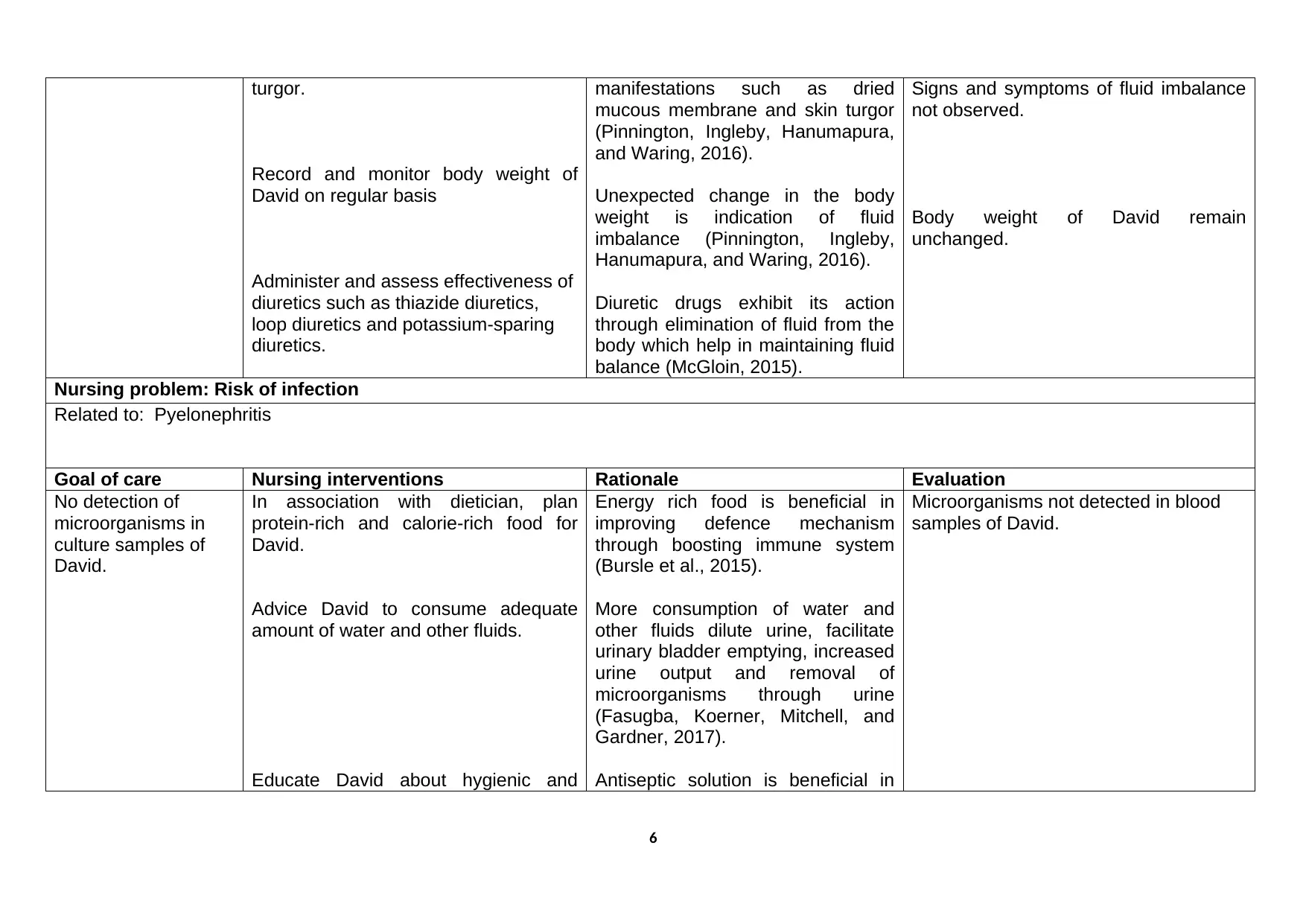
turgor.
Record and monitor body weight of
David on regular basis
Administer and assess effectiveness of
diuretics such as thiazide diuretics,
loop diuretics and potassium-sparing
diuretics.
manifestations such as dried
mucous membrane and skin turgor
(Pinnington, Ingleby, Hanumapura,
and Waring, 2016).
Unexpected change in the body
weight is indication of fluid
imbalance (Pinnington, Ingleby,
Hanumapura, and Waring, 2016).
Diuretic drugs exhibit its action
through elimination of fluid from the
body which help in maintaining fluid
balance (McGloin, 2015).
Signs and symptoms of fluid imbalance
not observed.
Body weight of David remain
unchanged.
Nursing problem: Risk of infection
Related to: Pyelonephritis
Goal of care Nursing interventions Rationale Evaluation
No detection of
microorganisms in
culture samples of
David.
In association with dietician, plan
protein-rich and calorie-rich food for
David.
Advice David to consume adequate
amount of water and other fluids.
Educate David about hygienic and
Energy rich food is beneficial in
improving defence mechanism
through boosting immune system
(Bursle et al., 2015).
More consumption of water and
other fluids dilute urine, facilitate
urinary bladder emptying, increased
urine output and removal of
microorganisms through urine
(Fasugba, Koerner, Mitchell, and
Gardner, 2017).
Antiseptic solution is beneficial in
Microorganisms not detected in blood
samples of David.
6
Record and monitor body weight of
David on regular basis
Administer and assess effectiveness of
diuretics such as thiazide diuretics,
loop diuretics and potassium-sparing
diuretics.
manifestations such as dried
mucous membrane and skin turgor
(Pinnington, Ingleby, Hanumapura,
and Waring, 2016).
Unexpected change in the body
weight is indication of fluid
imbalance (Pinnington, Ingleby,
Hanumapura, and Waring, 2016).
Diuretic drugs exhibit its action
through elimination of fluid from the
body which help in maintaining fluid
balance (McGloin, 2015).
Signs and symptoms of fluid imbalance
not observed.
Body weight of David remain
unchanged.
Nursing problem: Risk of infection
Related to: Pyelonephritis
Goal of care Nursing interventions Rationale Evaluation
No detection of
microorganisms in
culture samples of
David.
In association with dietician, plan
protein-rich and calorie-rich food for
David.
Advice David to consume adequate
amount of water and other fluids.
Educate David about hygienic and
Energy rich food is beneficial in
improving defence mechanism
through boosting immune system
(Bursle et al., 2015).
More consumption of water and
other fluids dilute urine, facilitate
urinary bladder emptying, increased
urine output and removal of
microorganisms through urine
(Fasugba, Koerner, Mitchell, and
Gardner, 2017).
Antiseptic solution is beneficial in
Microorganisms not detected in blood
samples of David.
6
⊘ This is a preview!⊘
Do you want full access?
Subscribe today to unlock all pages.

Trusted by 1+ million students worldwide
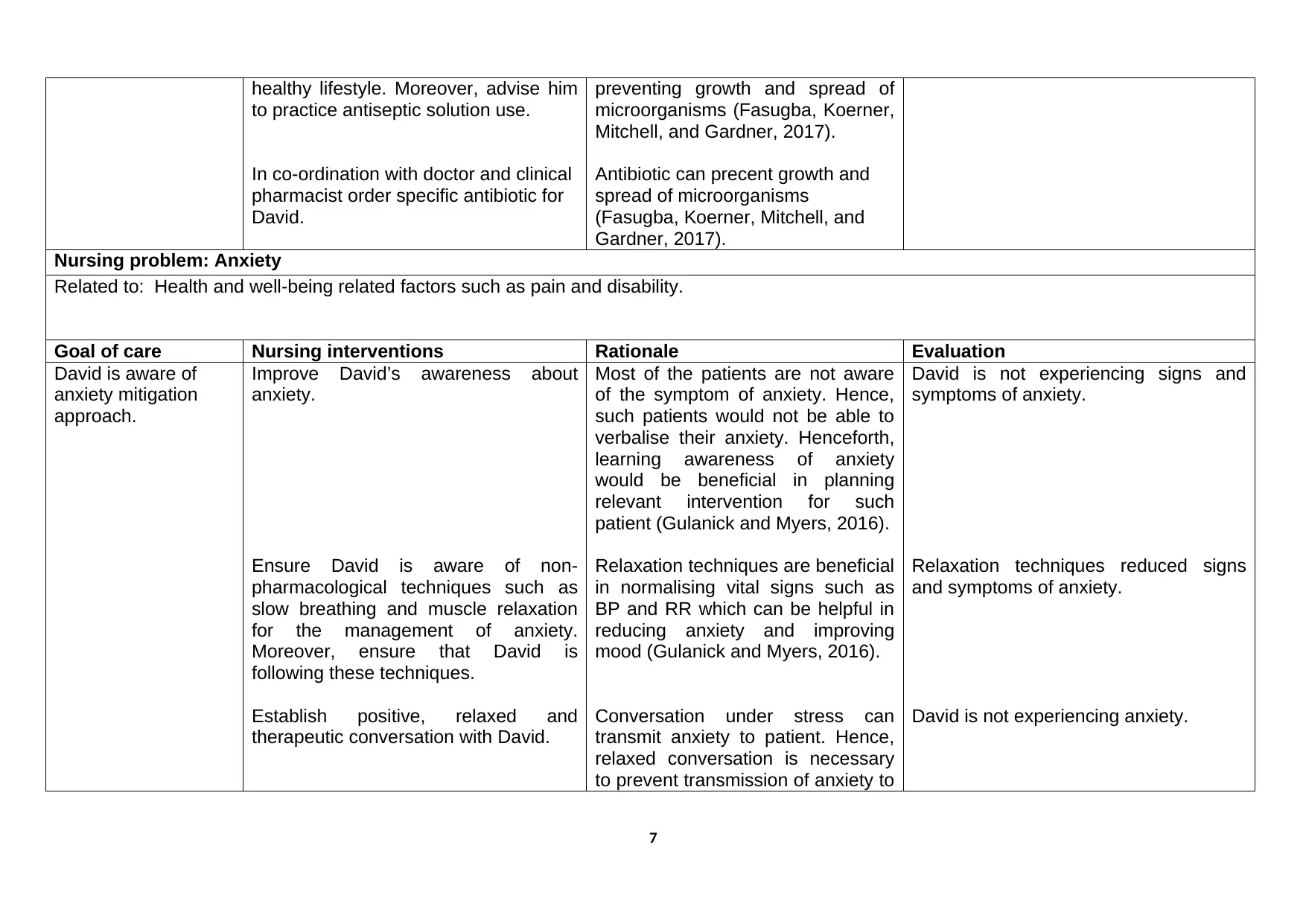
healthy lifestyle. Moreover, advise him
to practice antiseptic solution use.
In co-ordination with doctor and clinical
pharmacist order specific antibiotic for
David.
preventing growth and spread of
microorganisms (Fasugba, Koerner,
Mitchell, and Gardner, 2017).
Antibiotic can precent growth and
spread of microorganisms
(Fasugba, Koerner, Mitchell, and
Gardner, 2017).
Nursing problem: Anxiety
Related to: Health and well-being related factors such as pain and disability.
Goal of care Nursing interventions Rationale Evaluation
David is aware of
anxiety mitigation
approach.
Improve David’s awareness about
anxiety.
Ensure David is aware of non-
pharmacological techniques such as
slow breathing and muscle relaxation
for the management of anxiety.
Moreover, ensure that David is
following these techniques.
Establish positive, relaxed and
therapeutic conversation with David.
Most of the patients are not aware
of the symptom of anxiety. Hence,
such patients would not be able to
verbalise their anxiety. Henceforth,
learning awareness of anxiety
would be beneficial in planning
relevant intervention for such
patient (Gulanick and Myers, 2016).
Relaxation techniques are beneficial
in normalising vital signs such as
BP and RR which can be helpful in
reducing anxiety and improving
mood (Gulanick and Myers, 2016).
Conversation under stress can
transmit anxiety to patient. Hence,
relaxed conversation is necessary
to prevent transmission of anxiety to
David is not experiencing signs and
symptoms of anxiety.
Relaxation techniques reduced signs
and symptoms of anxiety.
David is not experiencing anxiety.
7
to practice antiseptic solution use.
In co-ordination with doctor and clinical
pharmacist order specific antibiotic for
David.
preventing growth and spread of
microorganisms (Fasugba, Koerner,
Mitchell, and Gardner, 2017).
Antibiotic can precent growth and
spread of microorganisms
(Fasugba, Koerner, Mitchell, and
Gardner, 2017).
Nursing problem: Anxiety
Related to: Health and well-being related factors such as pain and disability.
Goal of care Nursing interventions Rationale Evaluation
David is aware of
anxiety mitigation
approach.
Improve David’s awareness about
anxiety.
Ensure David is aware of non-
pharmacological techniques such as
slow breathing and muscle relaxation
for the management of anxiety.
Moreover, ensure that David is
following these techniques.
Establish positive, relaxed and
therapeutic conversation with David.
Most of the patients are not aware
of the symptom of anxiety. Hence,
such patients would not be able to
verbalise their anxiety. Henceforth,
learning awareness of anxiety
would be beneficial in planning
relevant intervention for such
patient (Gulanick and Myers, 2016).
Relaxation techniques are beneficial
in normalising vital signs such as
BP and RR which can be helpful in
reducing anxiety and improving
mood (Gulanick and Myers, 2016).
Conversation under stress can
transmit anxiety to patient. Hence,
relaxed conversation is necessary
to prevent transmission of anxiety to
David is not experiencing signs and
symptoms of anxiety.
Relaxation techniques reduced signs
and symptoms of anxiety.
David is not experiencing anxiety.
7
Paraphrase This Document
Need a fresh take? Get an instant paraphrase of this document with our AI Paraphraser

Educate David about the importance of
anti-anxiety medications. Order anti-
anxiety medications for David.
Discharge plan of David should include
counselling for psychological issues
from social workers, psychologist and
friends and family members
patient.
Anti-anxiety medications improve
mood and produce relaxed state
through increasing serotonin level.
Increase in awareness about
anxiety medications is necessary
because these patients should
remain adhered to these
medications because anti-anxiety
drugs exhibit delayed effect
(Gulanick and Myers, 2016).
Counselling for psychological issues
can be helpful in improving
confidence and dignity (Gulanick
and Myers, 2016).
Nursing problem: Impaired skin integrity
Related to: Hyperthermia and altered fluid status.
Goal of care Nursing interventions Rationale Evaluation
Skin remains intact
and absence of
redness on skin.
Advice David not to raise bed level
frequently and ensure he is using bed
lines as lifting devices.
Teach hygienic practices such as use
of antiseptic solution and pat drying to
David.
Heels friction and rubbing elbow
towards bed can lead to impaired
skin integrity (Murphree, 2017).
Infection can be reduced through
use of antiseptic solution. Skin
without infection can maintain skin
integrity. Pat drying is worthwhile
over rubbing because later can
produce rashes on the skin
(Kottner and Surber, 2016).
Skin remains intact.
8
anti-anxiety medications. Order anti-
anxiety medications for David.
Discharge plan of David should include
counselling for psychological issues
from social workers, psychologist and
friends and family members
patient.
Anti-anxiety medications improve
mood and produce relaxed state
through increasing serotonin level.
Increase in awareness about
anxiety medications is necessary
because these patients should
remain adhered to these
medications because anti-anxiety
drugs exhibit delayed effect
(Gulanick and Myers, 2016).
Counselling for psychological issues
can be helpful in improving
confidence and dignity (Gulanick
and Myers, 2016).
Nursing problem: Impaired skin integrity
Related to: Hyperthermia and altered fluid status.
Goal of care Nursing interventions Rationale Evaluation
Skin remains intact
and absence of
redness on skin.
Advice David not to raise bed level
frequently and ensure he is using bed
lines as lifting devices.
Teach hygienic practices such as use
of antiseptic solution and pat drying to
David.
Heels friction and rubbing elbow
towards bed can lead to impaired
skin integrity (Murphree, 2017).
Infection can be reduced through
use of antiseptic solution. Skin
without infection can maintain skin
integrity. Pat drying is worthwhile
over rubbing because later can
produce rashes on the skin
(Kottner and Surber, 2016).
Skin remains intact.
8
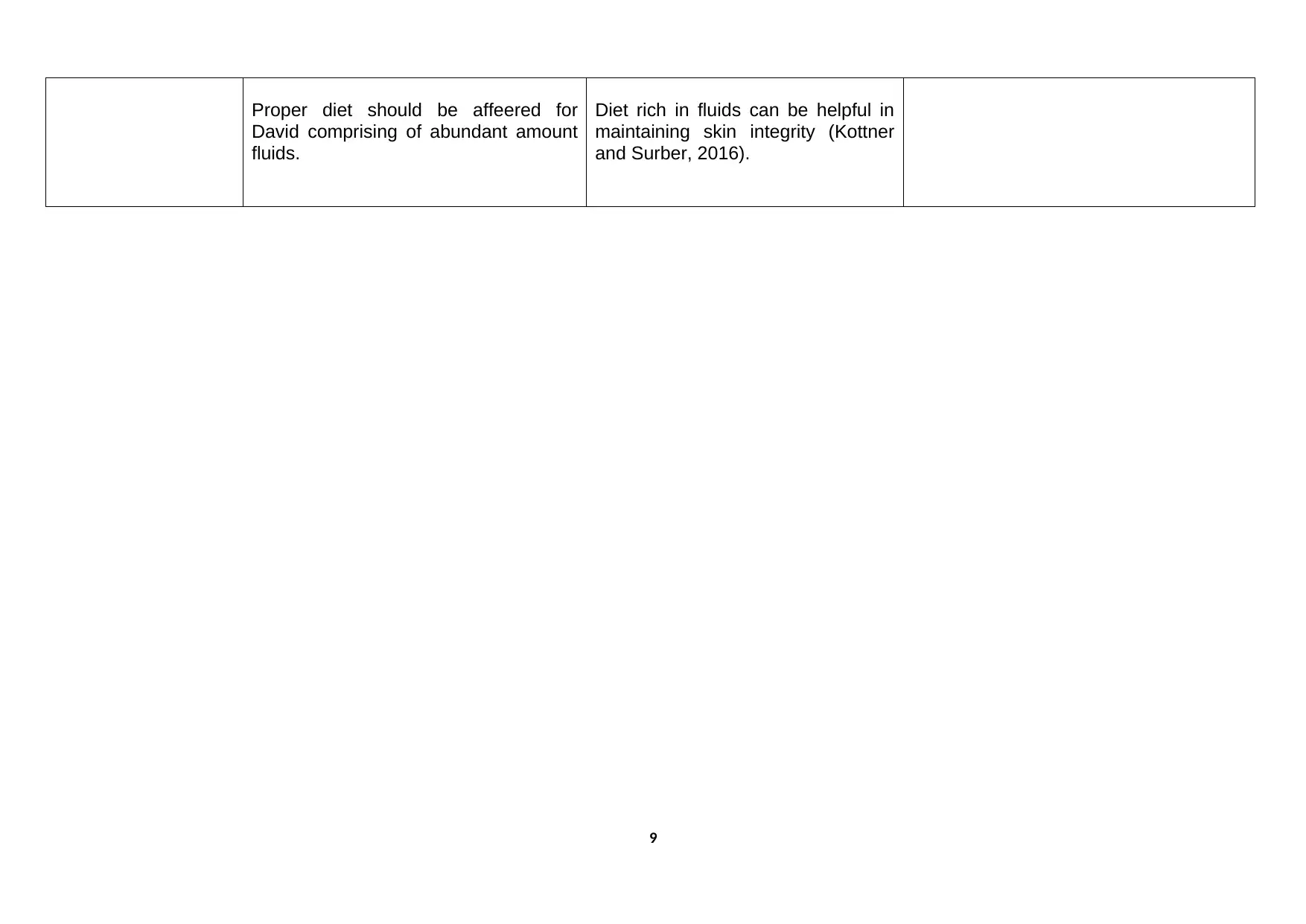
Proper diet should be affeered for
David comprising of abundant amount
fluids.
Diet rich in fluids can be helpful in
maintaining skin integrity (Kottner
and Surber, 2016).
9
David comprising of abundant amount
fluids.
Diet rich in fluids can be helpful in
maintaining skin integrity (Kottner
and Surber, 2016).
9
⊘ This is a preview!⊘
Do you want full access?
Subscribe today to unlock all pages.

Trusted by 1+ million students worldwide

Task 3
Fluid balance and acute pain are the two most important recommendations need to
be made for David. Regular observation and monitoring of these facets in David can
be helpful in improving his health and wellbeing because daily monitoring of fluid
balance and acute pain are necessary in AKI patients.
David should be made aware of the signs and symptoms of fluid balance such as
muscle weakness, confusion, lethargy, fatigue, lethargy, and muscle cramping.
Hence, David can inform nurse about these symptoms which facilitate planning of
early intervention for David. He should be advised to consume ample quantity of
water and other fluids. David should be instructed to inform nurse about improvement
in his signs and symptoms after consumption of fluids. If there is no essential
improvement in his condition; nurse can take necessary action to switch intervention
to IV fluid administration (Lemone et al., 2017). David should be instructed to observe
and monitor body weight on daily basis because fluid balance can produce sudden
change in the body weight.
It is necessary to improve awareness of David related to acute pain associated with
AKI. He should be informed that his pain is merely due to AKI and it is not due to
other conditions. AKI manifestations such as urinary distension and increased
pressure are attributable to pain. Pain in kidney disease usually radiate towards
lower back; hence, he should be informed not to worry about his lower back pain
(Meersch, Volmering, and Zarbock, 2017). Henceforth, it is necessary for him to
focus to reduce pain associated with kidney disease. David should be made aware of
pain assessment factors such as time, quality, intensity and location of pain. Hence,
he can notify these pain assessment factors to nurse which would be helpful for the
nurse to take necessary action. Ensure David is using accessories such as warm
baths or heating pads which can be beneficial in reducing duration and intensity of
pain. Advise David to take abundant amount of water and fluid on the daily basis
because it can be beneficial in diluting urine and reducing bladder irritation (Meersch,
Volmering, and Zarbock, 2017; Bryant, Knights, Darroch, and Rowland, 2018).
Task 4
10
Fluid balance and acute pain are the two most important recommendations need to
be made for David. Regular observation and monitoring of these facets in David can
be helpful in improving his health and wellbeing because daily monitoring of fluid
balance and acute pain are necessary in AKI patients.
David should be made aware of the signs and symptoms of fluid balance such as
muscle weakness, confusion, lethargy, fatigue, lethargy, and muscle cramping.
Hence, David can inform nurse about these symptoms which facilitate planning of
early intervention for David. He should be advised to consume ample quantity of
water and other fluids. David should be instructed to inform nurse about improvement
in his signs and symptoms after consumption of fluids. If there is no essential
improvement in his condition; nurse can take necessary action to switch intervention
to IV fluid administration (Lemone et al., 2017). David should be instructed to observe
and monitor body weight on daily basis because fluid balance can produce sudden
change in the body weight.
It is necessary to improve awareness of David related to acute pain associated with
AKI. He should be informed that his pain is merely due to AKI and it is not due to
other conditions. AKI manifestations such as urinary distension and increased
pressure are attributable to pain. Pain in kidney disease usually radiate towards
lower back; hence, he should be informed not to worry about his lower back pain
(Meersch, Volmering, and Zarbock, 2017). Henceforth, it is necessary for him to
focus to reduce pain associated with kidney disease. David should be made aware of
pain assessment factors such as time, quality, intensity and location of pain. Hence,
he can notify these pain assessment factors to nurse which would be helpful for the
nurse to take necessary action. Ensure David is using accessories such as warm
baths or heating pads which can be beneficial in reducing duration and intensity of
pain. Advise David to take abundant amount of water and fluid on the daily basis
because it can be beneficial in diluting urine and reducing bladder irritation (Meersch,
Volmering, and Zarbock, 2017; Bryant, Knights, Darroch, and Rowland, 2018).
Task 4
10
Paraphrase This Document
Need a fresh take? Get an instant paraphrase of this document with our AI Paraphraser
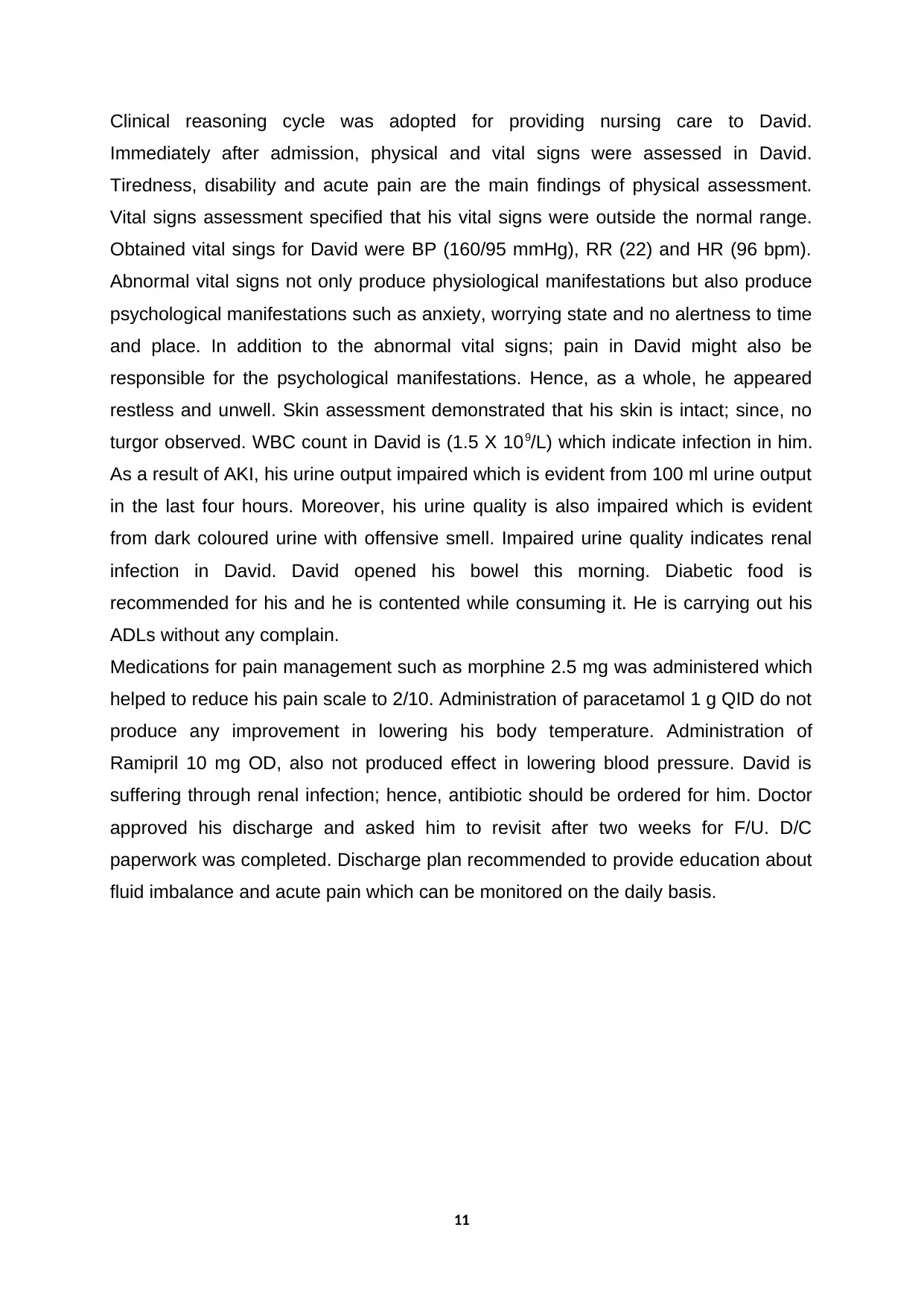
Clinical reasoning cycle was adopted for providing nursing care to David.
Immediately after admission, physical and vital signs were assessed in David.
Tiredness, disability and acute pain are the main findings of physical assessment.
Vital signs assessment specified that his vital signs were outside the normal range.
Obtained vital sings for David were BP (160/95 mmHg), RR (22) and HR (96 bpm).
Abnormal vital signs not only produce physiological manifestations but also produce
psychological manifestations such as anxiety, worrying state and no alertness to time
and place. In addition to the abnormal vital signs; pain in David might also be
responsible for the psychological manifestations. Hence, as a whole, he appeared
restless and unwell. Skin assessment demonstrated that his skin is intact; since, no
turgor observed. WBC count in David is (1.5 X 109/L) which indicate infection in him.
As a result of AKI, his urine output impaired which is evident from 100 ml urine output
in the last four hours. Moreover, his urine quality is also impaired which is evident
from dark coloured urine with offensive smell. Impaired urine quality indicates renal
infection in David. David opened his bowel this morning. Diabetic food is
recommended for his and he is contented while consuming it. He is carrying out his
ADLs without any complain.
Medications for pain management such as morphine 2.5 mg was administered which
helped to reduce his pain scale to 2/10. Administration of paracetamol 1 g QID do not
produce any improvement in lowering his body temperature. Administration of
Ramipril 10 mg OD, also not produced effect in lowering blood pressure. David is
suffering through renal infection; hence, antibiotic should be ordered for him. Doctor
approved his discharge and asked him to revisit after two weeks for F/U. D/C
paperwork was completed. Discharge plan recommended to provide education about
fluid imbalance and acute pain which can be monitored on the daily basis.
11
Immediately after admission, physical and vital signs were assessed in David.
Tiredness, disability and acute pain are the main findings of physical assessment.
Vital signs assessment specified that his vital signs were outside the normal range.
Obtained vital sings for David were BP (160/95 mmHg), RR (22) and HR (96 bpm).
Abnormal vital signs not only produce physiological manifestations but also produce
psychological manifestations such as anxiety, worrying state and no alertness to time
and place. In addition to the abnormal vital signs; pain in David might also be
responsible for the psychological manifestations. Hence, as a whole, he appeared
restless and unwell. Skin assessment demonstrated that his skin is intact; since, no
turgor observed. WBC count in David is (1.5 X 109/L) which indicate infection in him.
As a result of AKI, his urine output impaired which is evident from 100 ml urine output
in the last four hours. Moreover, his urine quality is also impaired which is evident
from dark coloured urine with offensive smell. Impaired urine quality indicates renal
infection in David. David opened his bowel this morning. Diabetic food is
recommended for his and he is contented while consuming it. He is carrying out his
ADLs without any complain.
Medications for pain management such as morphine 2.5 mg was administered which
helped to reduce his pain scale to 2/10. Administration of paracetamol 1 g QID do not
produce any improvement in lowering his body temperature. Administration of
Ramipril 10 mg OD, also not produced effect in lowering blood pressure. David is
suffering through renal infection; hence, antibiotic should be ordered for him. Doctor
approved his discharge and asked him to revisit after two weeks for F/U. D/C
paperwork was completed. Discharge plan recommended to provide education about
fluid imbalance and acute pain which can be monitored on the daily basis.
11
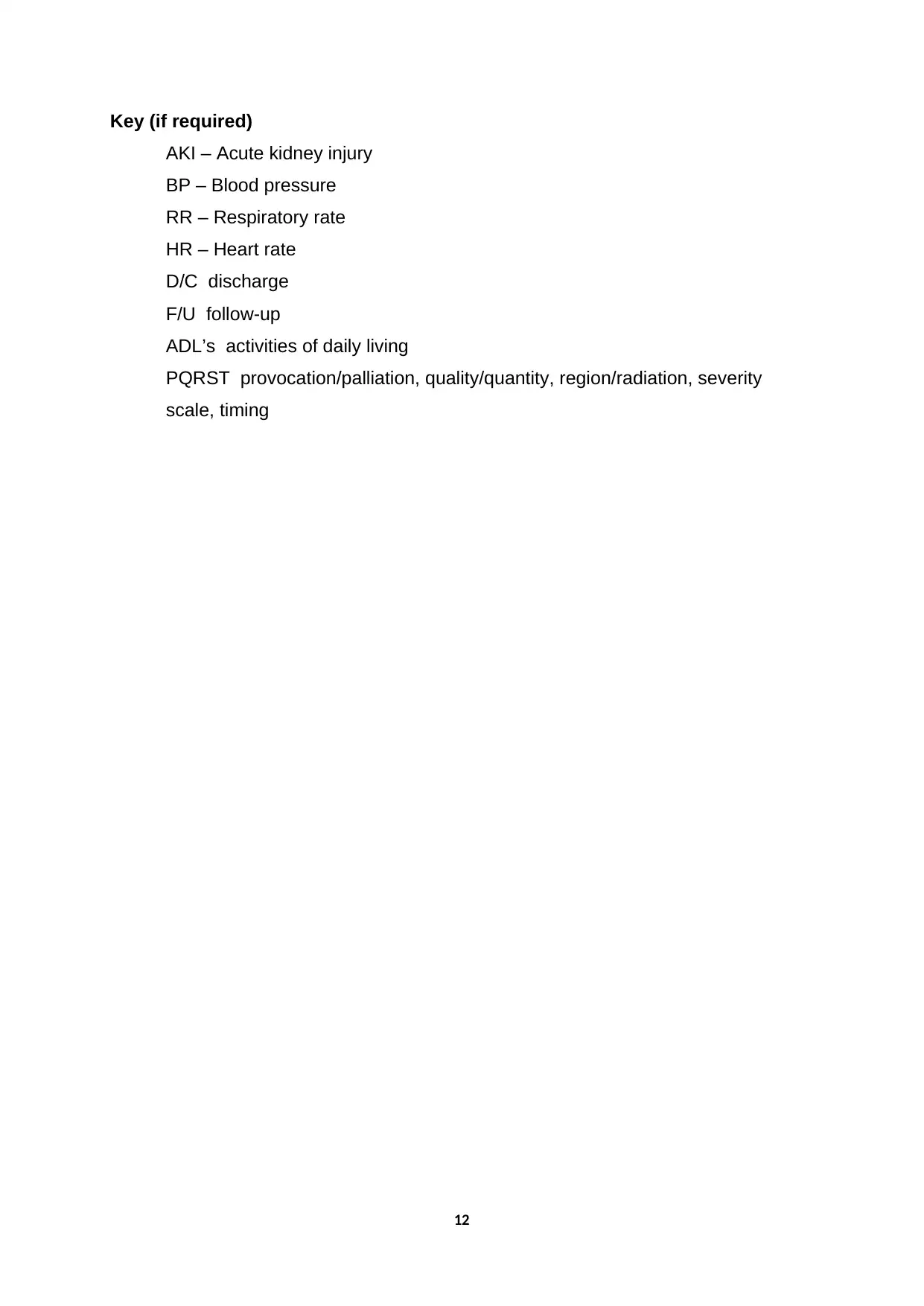
Key (if required)
AKI – Acute kidney injury
BP – Blood pressure
RR – Respiratory rate
HR – Heart rate
D/C discharge
F/U follow-up
ADL’s activities of daily living
PQRST provocation/palliation, quality/quantity, region/radiation, severity
scale, timing
12
AKI – Acute kidney injury
BP – Blood pressure
RR – Respiratory rate
HR – Heart rate
D/C discharge
F/U follow-up
ADL’s activities of daily living
PQRST provocation/palliation, quality/quantity, region/radiation, severity
scale, timing
12
⊘ This is a preview!⊘
Do you want full access?
Subscribe today to unlock all pages.

Trusted by 1+ million students worldwide
1 out of 14
Related Documents
Your All-in-One AI-Powered Toolkit for Academic Success.
+13062052269
info@desklib.com
Available 24*7 on WhatsApp / Email
![[object Object]](/_next/static/media/star-bottom.7253800d.svg)
Unlock your academic potential
Copyright © 2020–2025 A2Z Services. All Rights Reserved. Developed and managed by ZUCOL.





